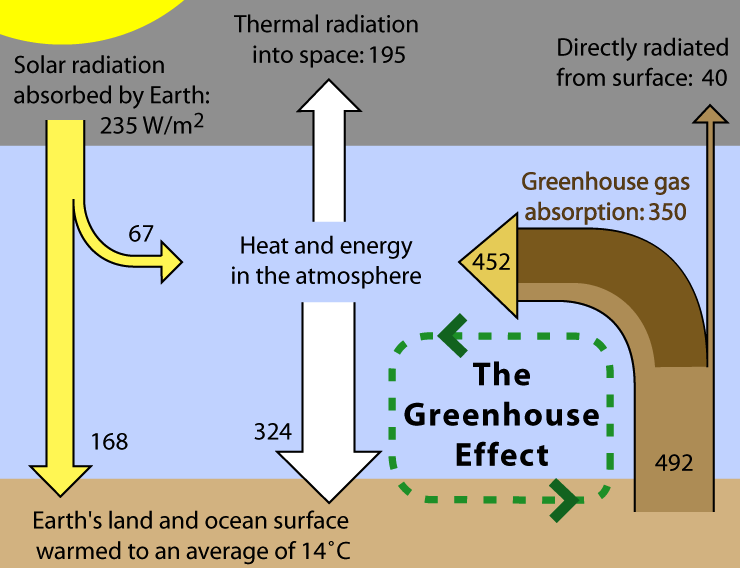From Wikipedia, the free encyclopedia

A schematic representation of the exchanges of energy between outer space, the Earth's atmosphere, and the Earth surface. The ability of the atmosphere to capture and recycle energy emitted by the Earth surface is the defining characteristic of the greenhouse effect
The greenhouse effect is the process in which the emission of infrared radiation by the atmosphere warms a planet's surface. The name comes from an incorrect analogy with the warming of air inside a greenhouse compared to the air outside the greenhouse. The Earth's average surface temperature is about 33°C warmer than it would be without the greenhouse effect. The greenhouse effect was discovered by Joseph Fourier in 1829 and first investigated quantitatively by Svante Arrhenius in 1896. In addition to the Earth, Mars and especially Venus have greenhouse effects.
For recent warming of the earth, see global warming.
The reason this warms the surface is most easily understood by starting with a simplified model of a purely radiative greenhouse effect that ignores energy transfer in the atmosphere by convection (sensible heat transport) and by the evaporation and condensation of water vapor (latent heat transport). In this purely radiative case, one can think of the atmosphere as emitting infrared radiation both upwards and downwards. The upward infrared flux emitted by the surface must balance not only the absorbed solar flux but also this downward infrared flux emitted by the atmosphere. The surface temperature will rise until it generates thermal radiation equivalent to the sum of the incoming solar and infrared radiation.
A more realistic picture taking into account the convective and latent heat fluxes is somewhat more complex. But the following simple model captures the essence. The starting point is to note that the opacity of the atmosphere to infrared radiation determines the height in the atmosphere from which most of the photons are emitted into space. If the atmosphere is more opaque, the typical photon escaping to space will be emitted from higher in the atmosphere, because one then has to go to higher altitudes to see out to space in the infrared. Since the emission of infrared radiation is a function of temperature, it is the temperature of the atmosphere at this emission level that is effectively determined by the requirement that the emitted flux balance the absorbed solar flux.
But the temperature of the atmosphere generally decreases with height above the surface, at a rate of roughly 6.5 °C per kilometer on average, until one reaches the stratosphere 10-15 km above the surface. (Most infrared photons escaping to space are emitted by the troposphere, the region bounded by the surface and the stratosphere, so we can ignore the stratosphere in this simple picture.) A very simple model, but one that proves to be remarkably useful, involves the assumption that this temperature profile is simply fixed, by the non-radiative energy fluxes. Given the temperature at the emission level of the infrared flux escaping to space, one then computes the surface temperature by increasing temperature at the rate of 6.5 °C per kilometer, the environmental lapse rate, until one reaches the surface. The more opaque the atmosphere, and the higher the emission level of the escaping infrared radiation, the warmer the surface, since one then needs to follow this lapse rate over a larger distance in the vertical. While less intuitive than the purely radiative greenhouse effect, this less familiar radiative-convective picture is the starting point for most discussions of the greenhouse effect in the climate modeling literature.










